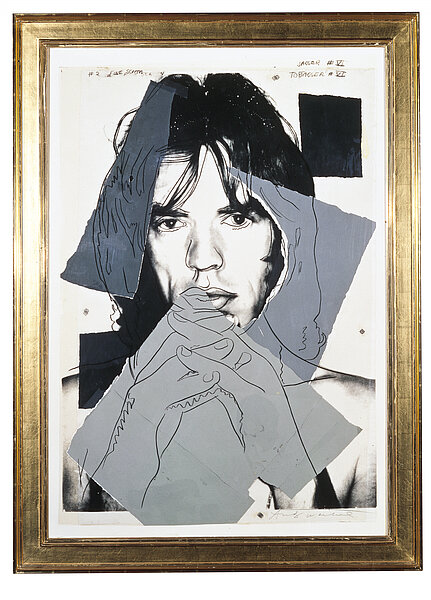mumok is closed until June 6, 2024 for renovation work.
All information about the renovation project and our alternative program can be found here.

Detail
Warhol, Andy
Mick Jagger,
1975
| Object category | image |
|---|---|
| Object description | Silkscreen, acetate on paper |
| Dimensions |
Weight:
weight: 11 kg
|
| Material |
Object:
Cellulose Acetat,
Siebdruckfarbe
Support:
paper
|
| Technique |
Object:
screen printing
|
| Inventory number | ÖL-Stg 149/0 |
| Year of acquisition | 1981 |
| Creditline | mumok - Museum moderner Kunst Stiftung Ludwig Wien, Leihgabe der Österreichischen Ludwig-Stiftung |
| Rights reference | Bildrecht, Wien |
| Further information | GND |
Andy Warhol, who since his youth was fascinated by the stardom and glamour of Hollywood has himself become a big star in the early seventies. The titles he’s been given in newspapers and magazines vary from pop star and pop genius to Großmogul, pope of pop art and high priest. In this time he once again proceeds with the production of pictures which he put beside in favor of film-, music- and magazine projects. Warhol doesn’t take the models for his silk screen process prints exclusively from the mass media anymore. Repeatedly, he himself takes photographs of his motives mostly of more or less of famous contemporaries. He transfers then on the canvas and strongly modifies the whole picture. In the portrait of Mick Jagger the aspect of drawing is used again like in his early oeuvre. One of Warhol’s assistant’s comments on the circumstances at this phase: “Most of the people that Andy had to do with in his later years contributed nothing to the development of his art as far as ideas, suggestions and so on are concerned. That only happened during the period when he made his early pictures, between 1962 and 1970. It was then that he met people that gave him important creative impulses. In my opinion it is his last pictures that most clearly lack something. He had become something of a court painter.”
© mumok – museum moderner kunst stiftung ludwig wien
















